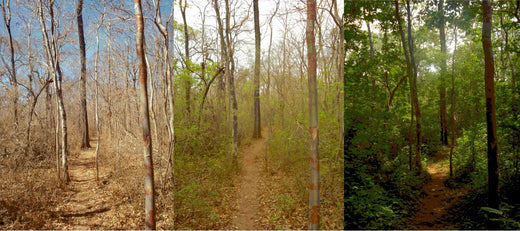When we think of the Atlantic Forest, lush tropical rainforests may come to mind. However, this vast and diverse biome also includes a lesser-known but equally impressive ecosystem: the Deciduous Seasonal Forests, commonly known as the Tropical Dry Forest.
These forests are part of the Atlantic Forest biome, which stretches across the northeastern and southeastern regions of Brazil and is one of the most diverse and threatened ecosystems in the world, home to incredible biodiversity and cultural heritage. Environmentalists stress that this ecosystem is so crucial to biodiversity that it requires special protection. This forested ecoregion is surrounded by the open vegetation of the Caatinga to the north and east and by the Cerrado to the west and south.
The Tropical Dry Forest may appear "dead" during the dry season, but it is simply nature activating its survival mode to withstand extreme climate conditions and intense heat!
The Tropical Dry Atlantic Forest is a unique and endangered biome that holds invaluable treasures of biodiversity and culture. Spread across the semi-arid regions of northeastern Brazil, this ecosystem is a symbol of resilience, beauty, and opportunity. Among its treasures is the Aroeira tree (Myracrodruon urundeuva), whose flowers give rise to one of the world’s rarest and most exquisite honeys: Aroeira Honey.
At Urihi Superfoods, we take pride in offering Aroeira Honey—a product deeply rooted in the traditions of the Tropical Dry Atlantic Forest. This honey not only provides a unique flavor experience but also tells the story of this fragile and beautiful ecosystem.
The Unique Charm of the Tropical Dry Atlantic Forests
The Tropical Dry Atlantic Forests thrive in regions with lower rainfall and seasonal drought periods. They are characterized by:
- Remarkable plant diversity: Many of the plants in this ecosystem are endemic. The deciduous trees and shrubs are adapted to withstand drought conditions and include xerophytic plants (such as cacti, bromeliads, and succulents). The Brazilwood tree (Caesalpinia echinata), known for its historical importance and valuable timber, can also be found here.
- Rich wildlife: Mammals, birds, reptiles, amphibians, and a wide variety of frogs and lizards inhabit this biome.
- Well-defined seasons: The region receives moderate rainfall, typically between 700 and 1,200 millimeters per year, concentrated during the rainy season from April to July. The dry season, from August to March, has minimal precipitation, explaining the biome's name and the adaptations of its plants and animals to survive the drought.
- Cultural importance: The communities living near these forests have developed sustainable practices that align with the challenging environment.
Why Protect the Tropical Dry Forest?
The Tropical Dry Forest is threatened by deforestation, agriculture, and climate change. Illegal logging, mining, and infrastructure development further contribute to the fragmentation and degradation of these forests. These pressures endanger the survival of many species and the ecological integrity of the forests. More than 90% of the original Atlantic Forest biome has been lost, and the dry forests face particular challenges due to their specific climatic conditions.
Protecting this ecosystem is essential to:
- Preserve biodiversity: These forests are home to countless species that exist nowhere else in the world.
- Value traditional knowledge: Local communities possess valuable insights into the sustainable management of these lands.
- Combat climate change: Forests like this are important carbon sinks and play a role in regional climate stability.
Urihi Superfoods: A Commitment to Sustainability
At Urihi Superfoods, we are dedicated to connecting people with the natural wonders of endangered ecosystems. By choosing Aroeira Honey, you are not just tasting a rare and delicious product—you are making a statement: you are supporting the communities that protect this ecosystem.
Savor the Essence of the Tropical Dry Atlantic Forest
Discover the incomparable flavor of Aroeira Honey and join us in celebrating and protecting one of Brazil’s most extraordinary ecosystems. Together, we can turn every purchase into a step toward a more sustainable future.
Author: Valentina Masso Ardila

